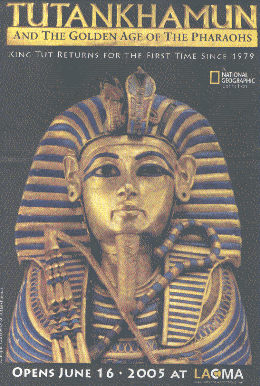 |
|
|
Revenge of The Mummy: Why Tut Intrigues
By ROSANNA MAH, The Independent Staff Writer 22.JUN.05
The night before the King Tutankhamun exhibit was unveiled for reporters, I sat at home debating the best way to study the history of the boy king who had been dead for 3,300 years.
After reading a slew of articles on the history of the boy king, I decided there was no fitting manner to prepare for an Egyptian-themed blockbuster than to watch one.
Popping ďThe MummyĒ into the DVD player, I eagerly absorbed the lore of Hollywoodís fictionalization of the curse of the mummy for two hours late into the night, watching the carved stone tombs and gilded treasures of Hamunaptra (City of the Dead) as ancient mummies came to life.
For months, many ó myself included ó have long awaited the return of Tut, who was first discovered by British archeologist Howard Carter in 1922, near the Valley of the Kings. Rumors have swirled that Tut had been murdered at age 19 or 20 by his closest advisor, Aye, with a blow to the head.
A recent CAT scan, however, proved otherwise and revealed the bone fragment in Tutís skull may have been caused by the embalming process or by Carterís mishandling of the mummy. Instead, scientists now say that Tutís left leg was broken badly above the knee and he may have died from infection.
To this day, the mystery behind the pharoah''s life and death have left much to the publicís imagination and romantic musings. Museum officials sold 300,000 advance tickets and set a new record in advance ticket sales and anticipated at least 1.2 million visitors would marvel at this museum exhibit.
My editor raved about the 1978 Tut I exhibit at the Los Angeles County Museum of Art, which introduced an era of museum blockbusters, where he left enlightened and short of $200 after a visit to the souvenir store.
For the Tut sequel, Zahi Hawass, the secretary general of the Egyptian Supreme Council of Antiquities (referred by The New York Times as a real-life ďIndiana JonesĒ) promised that our hearts ďwould trembleĒ at the sight of the exhibit that showcased 114 objects, including 50 from Tutís tomb and the rest from his ancestors.
With that much media foreplay on King Tut, I figure it better be something like a Joel Schumacher film ó lavished with over-the-top action and side effects that would ravish the senses and blow me away. I only wished I could have brought the popcorn.
What first greeted visitors was a dark chamber, the first of 11 galleries, where a wooden torso of King Tut remained brightly illuminated by spotlights and set high on a pedestal.
Our tour guide David Silverman, the national curator of the exhibit, was armed with a wealth of knowledge and droned on about the history of Egyptian royalty, rattling off unpronounceable names effortlessly and highlighting objects for review. With time being of essence, it was frequently hard to admire one or two sacred treasures before our guide hustled us into another gallery.
After the third gallery, I gave up trying to keep up with the marathon tour and broke away to enjoy Tut at my leisure. After all, if anyone needed monotonous expert opinion, theyíll know where to find a Borders store.
In the center of one gallery lay a wood coffin of Tutís great-grandmother, Tjuya, surrounded by close to two dozen objects, including a row of shabtis (statuettes) from 1400 B.C.E. to 1353 B.C.E, a chair, a chest to accompany the queen into the afterlife.
Then there was Tut.
At the entrance, a pair of wood figures depicted Tut as the King of Upper and Lower Egypt. A tiny childís chair and footrest, made of ebony and ivory, served as reminders of Tutís youth while regal accouterments, such as the golden and copper alloy flail and crook represented his royal office.
A beautiful and intricate gold shrine ó with pictorial engravings depicting scenes of everyday life between Tut and his wife Ankhesenamun ó gave insight to how Tut spent his days either hunting or being doted upon by his wife and slaves.
The centerpiece of the exhibition was a coffinette, that once held Tut''s embalmed liver, which stood with prominence in the center of the room in all of its glorified 16 inches.
Following that was a gallery titled ďDaily Life in Tutís WorldĒ where visitors may wonder at knickknacks like miniature board games, chests containing jewelry and perfumed oils, cosmetic jars and a model of a sailing ship ó a collection of objects of seeming unimportance.
But it was ďThe TombĒ which I rushed into with haste, expecting to see something of Tut''s final resting place only to be introduced to a digital projection of his mummy surrounded by five ornaments ó including an inlaid diadem or crown which encircled the boy kingís forehead and a gold dagger and sheath to ward off the dangers of the afterlife.
But where were the stone sarcophagus, mummified body, or even the gold burial mask that made its debut in the first exhibit? Where were the walls of hieroglyphics or promised splendor of gold?
Egyptian officials explained that those items were safeguarded in Cairo as they were too valuable to travel. But what would spectators be paying $30 for if not to set their eyes upon those priceless treasures?
Iíll be the first to declare that Iím neither art critic nor an educated museum goer, despite having the pleasure of visiting the renowned Louvre Museum in Paris and the Museum of London.
Iím simply an average Joe of the art world, a nobody.
But even I was highly unimpressed with the incoherent exhibit and left feeling ripped off.
The last gallery, titled ďThe Faces of Tutankhamun,Ē which contained a photographic series of CT scans performed on Tutís remains in January was so haphazard that it failed to educate or to capture oneís imagination.
http://www.kingtut.org/tickets.htm
